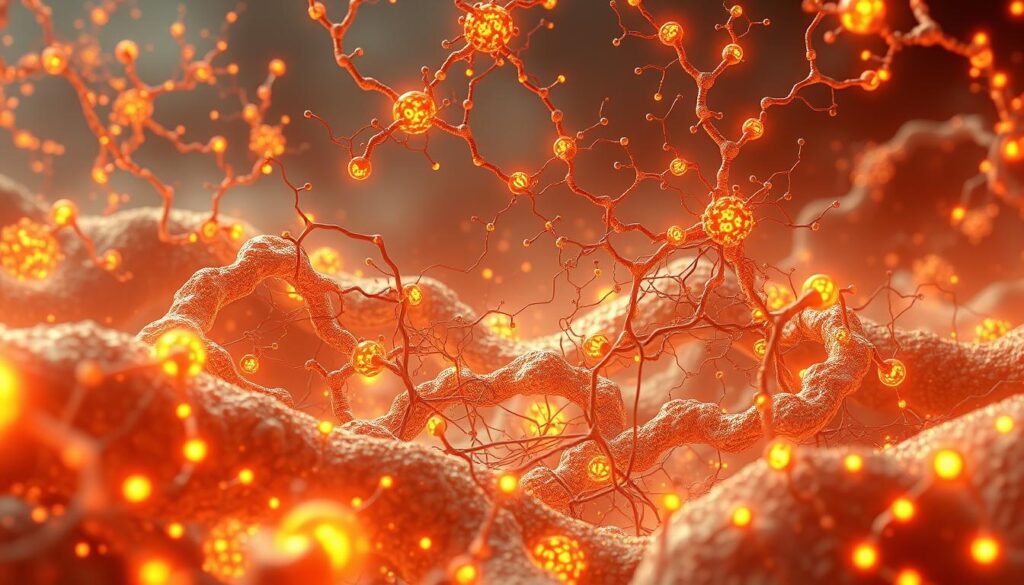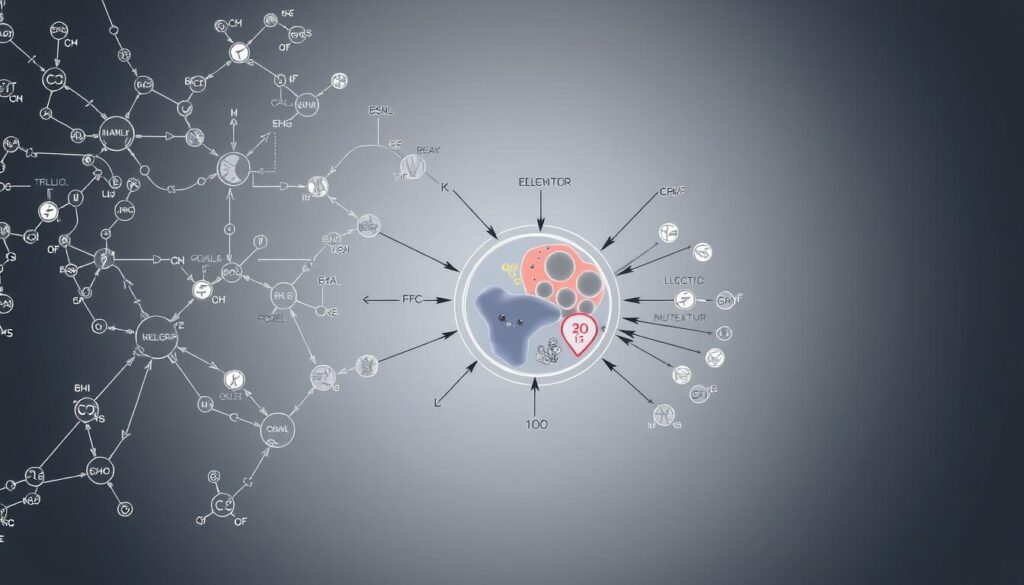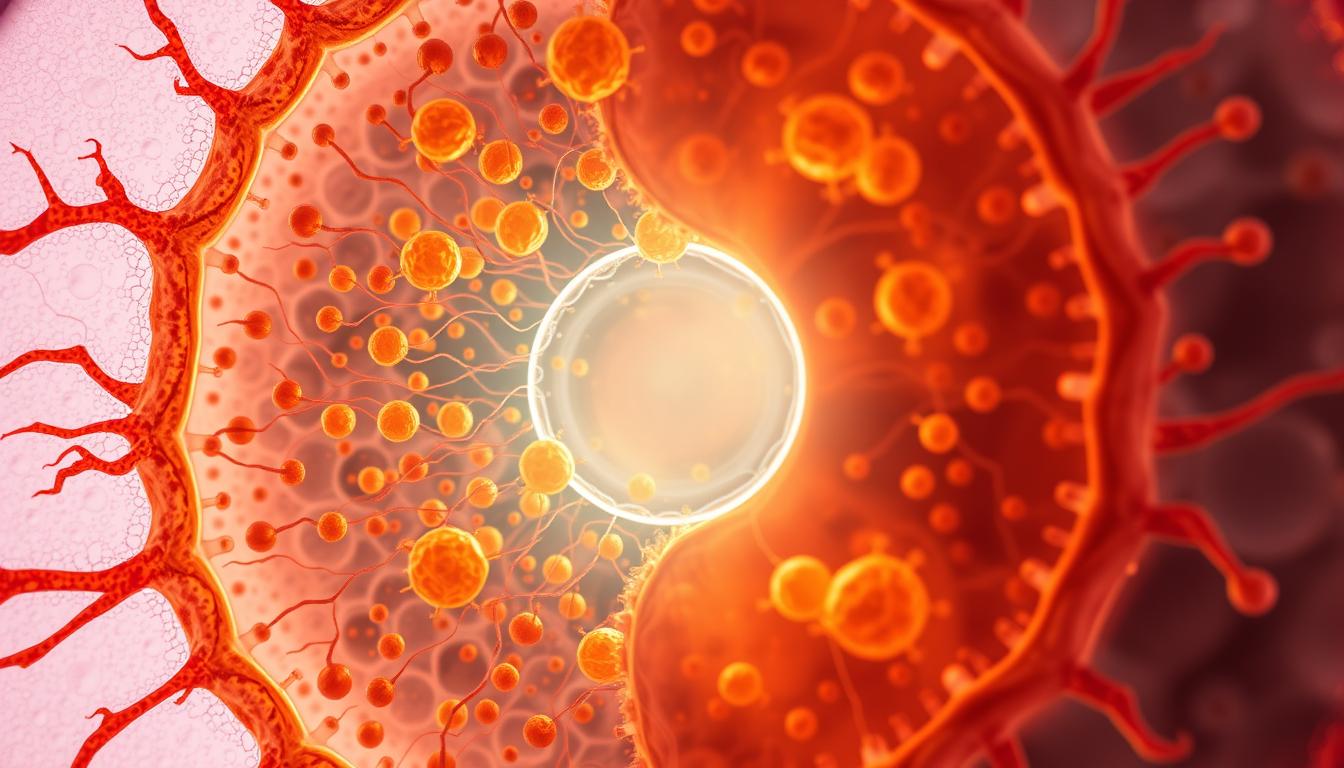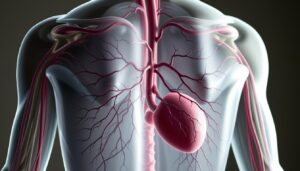Did you know humans deal with over 200,000 unique metabolites every day? This shows how complex our cells and metabolism are1. Our bodies are like complex systems working together to keep us healthy.
More than 30% of our genes help with metabolism. This lets our bodies do about 3,000 chemical reactions that keep us alive1. Knowing how these processes work can help us make better health choices.
Every cell in us is like a tiny factory, always changing and reacting to our surroundings. Keeping our cells healthy depends on what we eat, our genes, and how we live. Our metabolism is key to our overall health.
Metabolism is about how nutrients, enzymes, and cell parts work together. Things like fats, sugars, and proteins are important for our cells and immune system2. By understanding these basics, we can help our bodies heal and stay healthy.
Key Takeaways
- Humans interact with over 200,000 metabolites daily
- 30% of human genes are involved in metabolic processes
- Cellular health is dynamic and responsive to lifestyle choices
- Nutrients play a crucial role in cellular metabolism
- Understanding metabolic processes empowers personal health management
Understanding Cellular Organization and Structure
Your body is made up of tiny cells, each working like a tiny machine. Knowing how cells are structured helps us see how our bodies stay healthy.
Cells are amazing biological units with complex systems. The cell membrane is key, controlling what goes in and out3. It makes sure only important molecules get in.
Cell Membrane and Transport Systems
Your cell membrane is like a smart gatekeeper. It manages the flow of molecules through different ways:
- Passive transport (diffusion)
- Active transport needing energy
- Facilitated diffusion
- Osmosis
Organelles and Their Cellular Functions
Different organelles do special jobs in your cells. Mitochondria, known as powerhouses, make energy through complex processes3. They turn nutrients into energy, helping your body work every day.
Nuclear Control and Genetic Expression
The nucleus controls how genes are expressed, acting as the cell’s boss. Your DNA gives instructions for making proteins and controlling cell activities3. Research shows cells work in precise timing, from milliseconds to hours3.
Cellular function is a dance of molecular precision, where each component plays a crucial role in maintaining your body’s health.
Learning about these cell mechanisms shows us how our bodies work at their core. It reveals the incredible complexity of life.
The Building Blocks of Life: How Cellular, Metabolic, and Systemic Health Shape
Your body is a complex network of systems working together. Health starts at the cellular level, where metabolic processes lay the groundwork for wellness4. Each part of your body plays a key role in keeping you healthy.
Metabolic pathways are complex systems that help your body use energy. They include two main processes:
- Anabolism: Building complex molecules
- Catabolism: Breaking down complex molecules
Cellular metabolism is key for energy production and control. Glycolysis breaks down glucose, creating important compounds4. The full oxidation of pyruvate in mitochondria boosts energy efficiency4.
“The human body is a complex ecosystem where every cellular process is interconnected and vital to overall health.”
Your metabolic health is affected by age and lifestyle. Up to one-third of U.S. adults face metabolic challenges that affect their health5. Knowing these connections helps you make better choices for your health.
The connection between cellular processes, metabolic pathways, and systemic functions shows the need for a holistic health approach. By understanding your body’s balance, you can better support your well-being.
Enzymatic Self-Organization in Living Systems
Cellular metabolism depends on enzymes working together. They keep life’s basic processes running smoothly. Your body’s metabolic pathways are like well-organized systems, ensuring everything works well6.
Enzymes are key in cellular metabolism, speeding up complex reactions. They form teams called multienzymatic complexes. These teams make reactions much more efficient6.
Multienzymatic Complexes: Molecular Teamwork
Think of enzymes as skilled workers in a well-run factory. These teams work together to make metabolic processes better. They create amazing teamwork that boosts how well cells work7.
- Enzymes form intricate networks within cells
- Complex interactions optimize metabolic pathways
- Molecular assemblies increase reaction speed
Temporal Organization of Enzymes
The timing of enzymatic reactions is just as important as their makeup. Your body’s metabolic systems work with perfect timing. This ensures biochemical processes happen at the right moment6.
| Enzymatic Characteristic | Functional Significance |
|---|---|
| Spatial Arrangement | Increases reaction efficiency |
| Temporal Coordination | Optimizes metabolic pathways |
| Adaptive Response | Enables rapid cellular adjustments |
Metabolic Subsystems
Your body’s metabolic subsystems are complex networks of enzymes. These systems change with the environment, showing how living things can self-organize8.
Metabolic Networks and Energy Production

Your body’s energy system is a complex web of processes. It powers every cell and function. Cellular respiration turns nutrients into energy, mainly through ATP production9. This network lets your body turn food into fuel efficiently.
Energy metabolism involves key pathways working together. Thousands of metabolic networks have been found in different species9. Your body’s energy creation relies on detailed molecular interactions that get the most from what you eat.
- Glycolysis breaks down glucose into pyruvate
- Citric acid cycle generates high-energy molecules
- Oxidative phosphorylation produces ATP
Metabolic flexibility is key to keeping energy balanced. Your body can adjust to different energy needs, like during exercise or fasting10. This flexibility helps keep energy production steady under various conditions.
Interestingly, energy metabolism efficiency can change. During long fasting, ketone bodies can make a lot of ATP, showing your body’s amazing metabolic skills10. Knowing how energy is made helps us understand better health and performance.
Energy is not created or destroyed, but transformed through complex metabolic networks.
The study of energy metabolism is fascinating. It shows how your body’s cells turn nutrients into life-giving energy11.
Essential Nutrients and Metabolic Function
Your body’s metabolic processes need a balance of nutrients to work right. Knowing how nutrients help metabolism can guide you to make better food choices for health12.
The human body needs a mix of nutrients for good metabolism. These include macronutrients and micronutrients that help with body functions13.
Macronutrients and Energy Metabolism
Macronutrients are the main energy sources for your body. They are:
- Carbohydrates (68.5% of recommended intake)
- Fats (18.5% of recommended intake)
- Proteins (13% of recommended intake)12
These nutrients are key in metabolism. For example, glucose and fatty acids can be stored as glycogen and triglycerides. This gives your body energy when it needs it13.
Micronutrients as Metabolic Cofactors
Micronutrients are crucial for metabolic processes. They help enzymes work right, keeping metabolic pathways in check11.
Water and Electrolyte Balance
Keeping water and electrolyte balance right is key for good metabolism. Your body needs energy for many things, like moving stuff around and making new stuff13.
Nutrition is not just about consuming calories, but about providing your body with the right balance of nutrients to support metabolic health.
Cellular Communication and Signaling Pathways

Your body has a complex network that lets cells talk to each other. This network is crucial for your body’s functions. Scientists have been studying this for over 168 years, starting in 185514.
Neurotransmitters and hormones are key messengers in this network. They send signals to cells through special receptors. In 1980, Martin Rodbell showed that cells work like cybernetic systems with three main parts: discriminators, transducers, and amplifiers14.
- Receptors are very specific in what they bind to.
- When receptors cluster together, cells can respond more strongly.
- Lipid rafts in cell membranes help signals move around.
Cell signaling leads to many different responses in cells. For example, neurotrophins can start a chain of reactions. This can lead to cell growth and more14.
| Signaling Component | Function | Characteristics |
|---|---|---|
| Receptors | Signal Recognition | 50-300 amino acid domains |
| Neurotransmitters | Message Transmission | Neurological communication |
| Hormones | Systemic Regulation | Endocrine system coordination |
Learning about these complex networks shows how your body stays healthy. It’s all about precise molecular interactions.
The Role of Mitochondria in Cellular Health
Your body’s energy comes from tiny powerhouses called mitochondria. These tiny parts are key to keeping your cells working well15.
Mitochondria make energy through a complex process called oxidative phosphorylation. This process can create over 30 ATP molecules from one glucose molecule. That’s much more than other ways of making energy15.
Energy Production and ATP Synthesis
The way cells make energy is complex. It happens inside mitochondria. Key parts include:
- Efficient ATP generation through electron transport chain
- High mitochondrial density near cell nuclei and synaptic areas15
- Dynamic mitochondrial movement to support metabolic demands
Mitochondrial Disease and Dysfunction
When mitochondria don’t work right, it can cause big health problems. These issues are linked to many conditions, such as:
- Neurological disorders
- Metabolic syndrome
- Cardiovascular diseases
- Inflammatory conditions15
Oxidative Stress Management
Mitochondria are key in fighting oxidative stress. They help control harmful free radicals, which is vital for cell health16. But, too much of these free radicals can harm cells15.
Learning about mitochondria can help you support your body’s energy. It might also help slow down cell aging.
Systemic Health and Homeostatic Balance
Your body’s health depends on how different systems work together. Homeostasis keeps everything balanced, making sure your body works well at all levels17. The nervous, endocrine, and immune systems work together to handle challenges.
The immune system is key in keeping you healthy by fighting off germs and controlling inflammation. It uses a lot of energy, up to 30% of what your body needs just to stay alive17. Being able to change how you use energy is important for staying healthy10.
Conditions like diabetes and obesity can harm your body’s health. They cause inflammation that affects many parts of your body17. How well your body controls sugar, fights inflammation, and talks to cells is crucial for staying healthy.
Knowing how your body works helps you make better choices. By improving how you use energy, eating right, and boosting your immune system, you help your body stay in balance. This supports your health for the long term.
FAQ
What is the primary function of the cell membrane?
How do mitochondria contribute to cellular health?
What are metabolic subsystems?
Why are micronutrients important for metabolic function?
How do cells communicate with each other?
What is homeostasis?
How do macronutrients support energy metabolism?
What role does the nucleus play in cellular health?
What are multienzymatic complexes?
How do oxidative stress and mitochondrial health interact?
Source Links
- Principles and functions of metabolic compartmentalization – https://pmc.ncbi.nlm.nih.gov/articles/PMC10155461/
- Cellular metabolism regulates the differentiation and function of T-cell subsets – Cellular & Molecular Immunology – https://www.nature.com/articles/s41423-024-01148-8
- Elements of the cellular metabolic structure – https://pmc.ncbi.nlm.nih.gov/articles/PMC4428431/
- Complement-mediated regulation of metabolism and basic cellular processes – https://pmc.ncbi.nlm.nih.gov/articles/PMC5019180/
- Metabolic syndrome: Increased risk of cardiovascular disease, diabetes-Metabolic syndrome – Symptoms & causes – Mayo Clinic – https://www.mayoclinic.org/diseases-conditions/metabolic-syndrome/symptoms-causes/syc-20351916
- Biological Organization – https://www.cambridge.org/core/elements/biological-organization/8F618A9F6912A03B3A2AC8D6D754D53D
- Transfer of membrane(s) matter(s)—non-genetic inheritance of (metabolic) phenotypes? – https://pmc.ncbi.nlm.nih.gov/articles/PMC10955475/
- The brain is not mental! coupling neuronal and immune cellular processing in human organisms – https://www.frontiersin.org/journals/integrative-neuroscience/articles/10.3389/fnint.2023.1057622/pdf
- Unlocking Elementary Conversion Modes: ecmtool Unveils All Capabilities of Metabolic Networks – https://pmc.ncbi.nlm.nih.gov/articles/PMC7815953/
- Metabolic Flexibility as an Adaptation to Energy Resources and Requirements in Health and Disease – https://pmc.ncbi.nlm.nih.gov/articles/PMC6093334/
- Metabolic regulation of the immune system in health and diseases: mechanisms and interventions – Signal Transduction and Targeted Therapy – https://www.nature.com/articles/s41392-024-01954-6
- Metabolism – PMC – https://pmc.ncbi.nlm.nih.gov/articles/PMC7545035/
- Physiology, Metabolism – StatPearls – NCBI Bookshelf – https://www.ncbi.nlm.nih.gov/books/NBK546690/
- Conceptual Evolution of Cell Signaling – https://pmc.ncbi.nlm.nih.gov/articles/PMC6651758/
- Mitochondria: It is all about energy – https://pmc.ncbi.nlm.nih.gov/articles/PMC10167337/
- Multifaceted Roles of Mitochondrial Components and Metabolites in Metabolic Diseases and Cancer – https://pmc.ncbi.nlm.nih.gov/articles/PMC7352686/
- Systemic Immunometabolism: Challenges and Opportunities – https://pmc.ncbi.nlm.nih.gov/articles/PMC7491485/




